Marrying Vega and Zen: The AMD Ryzen 5 2400G Review
by Ian Cutress on February 12, 2018 9:00 AM ESTBenchmarking Performance: CPU System Tests
Our first set of tests is our general system tests. These set of tests are meant to emulate more about what people usually do on a system, like opening large files or processing small stacks of data. This is a bit different to our office testing, which uses more industry standard benchmarks, and a few of the benchmarks here are relatively new and different.
All of our benchmark results can also be found in our benchmark engine, Bench.
PDF Opening
First up is a self-penned test using a monstrous PDF we once received in advance of attending an event. While the PDF was only a single page, it had so many high-quality layers embedded it was taking north of 15 seconds to open and to gain control on the mid-range notebook I was using at the time. This put it as a great candidate for our 'let's open an obnoxious PDF' test. Here we use Adobe Reader DC, and disable all the update functionality within. The benchmark sets the screen to 1080p, opens the PDF to in fit-to-screen mode, and measures the time from sending the command to open the PDF until it is fully displayed and the user can take control of the software again. The test is repeated ten times, and the average time taken. Results are in milliseconds.
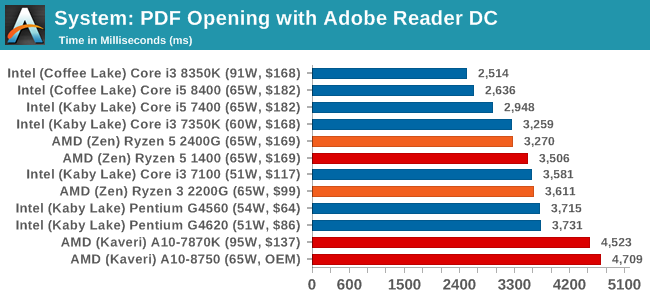
Our PDF test relies mostly on single core frequency, but memory frequency can also help. The 2400G pips the 1400, and the older AMD processors take a back seat. This is the sort of test that Intel's 4.2 GHz chips can take advantage off, as shown by the Core i3-8350K.
FCAT Processing: link
One of the more interesting workloads that has crossed our desks in recent quarters is FCAT - the tool we use to measure stuttering in gaming due to dropped or runt frames. The FCAT process requires enabling a color-based overlay onto a game, recording the gameplay, and then parsing the video file through the analysis software. The software is mostly single-threaded, however because the video is basically in a raw format, the file size is large and requires moving a lot of data around. For our test, we take a 90-second clip of the Rise of the Tomb Raider benchmark running on a GTX 980 Ti at 1440p, which comes in around 21 GB, and measure the time it takes to process through the visual analysis tool.
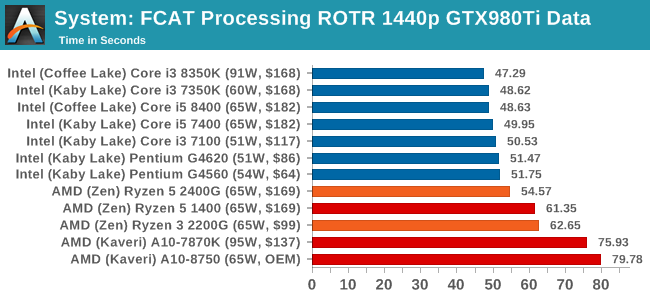
The FCAT program is single threaded, so again Intel's chips take a win here. The Ryzen 5 2400G takes another chunk out of the Ryzen 5 1400, due to its higher frequency.
Dolphin Benchmark: link
Many emulators are often bound by single thread CPU performance, and general reports tended to suggest that Haswell provided a significant boost to emulator performance. This benchmark runs a Wii program that ray traces a complex 3D scene inside the Dolphin Wii emulator. Performance on this benchmark is a good proxy of the speed of Dolphin CPU emulation, which is an intensive single core task using most aspects of a CPU. Results are given in seconds, where the Wii itself scores 1,052 seconds (17.53 minutes).
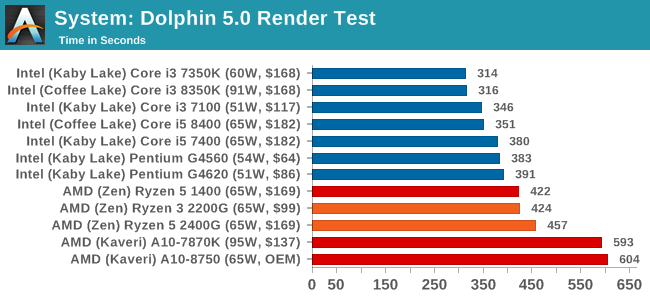
3D Movement Algorithm Test v2.1: link
This is the latest version of the self-penned 3DPM benchmark. The goal of 3DPM is to simulate semi-optimized scientific algorithms taken directly from my doctorate thesis. Version 2.1 improves over 2.0 by passing the main particle structs by reference rather than by value, and decreasing the amount of double->float->double recasts the compiler was adding in. It affords a ~25% speed-up over v2.0, which means new data.
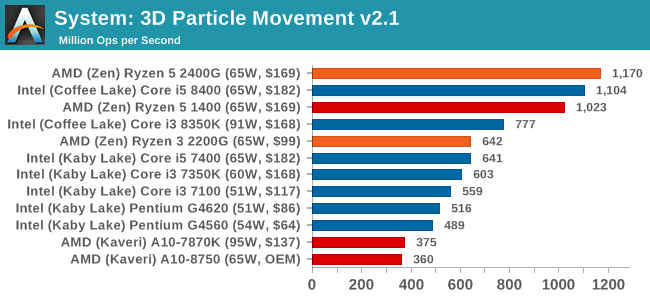
3DPM is our first multi-threaded test, and the Ryzen 5 2400G powers ahead over the 1400 due to frequency, and ahead the Core i3-8350K due to thread count. This is a benchmark that can take advantage of multithreading, so the quad-core APU with eight threads pushes ahead of the six-core Intel Core i5-8400.
DigiCortex v1.20: link
Despite being a couple of years old, the DigiCortex software is a pet project for the visualization of neuron and synapse activity in the brain. The software comes with a variety of benchmark modes, and we take the small benchmark which runs a 32k neuron/1.8B synapse simulation. The results on the output are given as a fraction of whether the system can simulate in real-time, so anything above a value of one is suitable for real-time work. The benchmark offers a 'no firing synapse' mode, which in essence detects DRAM and bus speed, however we take the firing mode which adds CPU work with every firing.
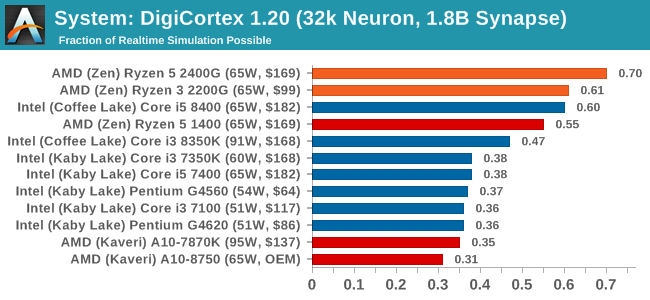
Agisoft Photoscan 1.3.3: link
Photoscan stays in our benchmark suite from the previous version, however now we are running on Windows 10 so features such as Speed Shift on the latest processors come into play. The concept of Photoscan is translating many 2D images into a 3D model - so the more detailed the images, and the more you have, the better the model. The algorithm has four stages, some single threaded and some multi-threaded, along with some cache/memory dependency in there as well. For some of the more variable threaded workload, features such as Speed Shift and XFR will be able to take advantage of CPU stalls or downtime, giving sizeable speedups on newer microarchitectures.
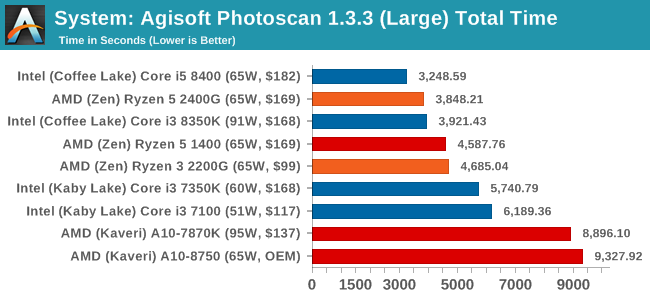
For Photoscan, certain elements of the algorithms require full cores to get the best performance, hence why the six-core CPU comes top and the Ryzen 5 2400G and Core i3-8350K are matched. That being said, the multithreading of the 2400G outweighs the extra frequency of the 8350K.










177 Comments
View All Comments
haplo602 - Tuesday, February 13, 2018 - link
Finally one review where I can see the driver version ... So this is the same driver used also for the Ryzen mobile APUs. Can you check if you can force/manual install the latest Adrenaline drivers ? That works on some of the Ryzen 2500u chips and actually increases the performance by some 15+% ...haplo602 - Tuesday, February 13, 2018 - link
I hope there's a memory scaling article in the future with frequency and CL scaling for the APU part ...crotach - Tuesday, February 13, 2018 - link
What about HTPC use?I was considering GT 1030 + Intel route for H265 and HDR10 playback and was really looking forward to Zen APUs, but there doesn't seem to be any motherboards with HDMI 2.0?!
Also, I wonder if the chips can be undervolted and underclocked to bring them to a near silent noise level for the living room.
Lolimaster - Tuesday, February 13, 2018 - link
You can undervolt and underclock ANY intel or amd cpu.forgerone - Tuesday, February 13, 2018 - link
What most writers and critics of integrated graphics processors such as AMD's APU or Intel iGP all seem to forget, is not EVERYONE in the world has a disposable or discretionary income equal to that of the United States, Europe, Japan etc. Not everyone can afford bleeding edge gaming PC's or laptops. Food, housing and clothing must come first for 80% of the population of the world.An APU can grant anyone who can afford at least a decent basic APU the enjoyment of playing most computer games. The visual quality of these games may not be up to the arrogantly high standards of most western gamers, but then again these same folks who are happy to have an APU also can not barely afford a 750p crt monitor much less a 4k flat screen.
This simple idea is huge not only for the laptop and pc market but especially game developers who can only expect to see an expansion of their Total Addressable Market. And that is good for everybody as broader markets help reduce the cost of development.
This in fact was the whole point behind AMD's release of Mantle and Microsoft and The Kronos Group's release of DX12 and Vulkan respectively.
Today's AMD APU has all of the power of a GPU Add In Board of not more than a several years back.
krazyfrog - Tuesday, February 13, 2018 - link
Why did you leave out the 8400 and the 1500X in these comparisons?Kamgusta - Wednesday, February 14, 2018 - link
Because these CPUs, while having the same price range, outperform these Raven Ridge chips. That would have been a bad press for AMD and it seems like Anandtech wants to remains extremely loyal to AMD in these days.msroadkill612 - Tuesday, February 13, 2018 - link
"the data shows both how far integrated graphics has come, and how far it still has to go to qualify for those 'immerse experiences' that Intel, AMD, and NVIDIA all claim are worth reaching for, with higher resolutions and higher fidelity. "This assumes a static situation which is rot.
what it reveals is that in the current paradigm, coders have coded accordingly for satisfactory results. If the paradigm changes and other ways work better, then code evolves.
This unprecedented integration of new gen, sibling cpu & gpu, offers many performance upsides too for future code.
picture a mobo with a discrete gpu like an equivalent 1030, then picture a ~matchbox footprint apu - there is a huge difference in the size of the respective circuits - yet they both do the same job & have to send a lot of data to each other.
it's not hard to figure which is inherently superior in many ways.
I strongly disagree with your blinkered bias.
Pork@III - Tuesday, February 13, 2018 - link
There is something unfinished, something inconsolable.elites2012 - Tuesday, February 13, 2018 - link
anything this chip lost to intel at, was most likely outdated. adobe, fcat, dolphin, pov are all outdated benchmarks.